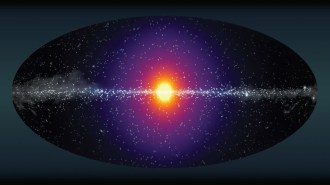Particle Physics
-
 Particle Physics
Particle PhysicsMeasuring the neutron’s lifetime from space could solve an enduring mystery
Measurements on Earth show that lone neutrons decay after about 15 minutes, and now scientists have measured that lifetime from space.
-
 Physics
PhysicsA star shredded by a black hole may have spit out an extremely energetic neutrino
A star’s fatal encounter with a black hole might have produced a neutrino with oomph.
-
 Space
SpaceA controversial X-ray glow didn’t show up in the Milky Way’s dark matter halo
A new look at old data suggests that an odd X-ray glow that emanates from some galaxies cannot come from decaying dark matter.
-
 Particle Physics
Particle PhysicsParticles called axions could reveal how matter conquered the universe
Axions, if they exist, may solve not one, not two, but three pressing puzzles of particle physics.
-
 Particle Physics
Particle PhysicsPhysicists have narrowed the mass range for hypothetical dark matter axions
In two new studies, scientists search for axions within new mass ranges but the particles remain elusive.
-
 Particle Physics
Particle PhysicsAntimatter hydrogen has the same quantum quirk as normal hydrogen
Atoms of antihydrogen are affected by the Lamb shift, which results from transient particles appearing and disappearing.
-
 Physics
PhysicsA barrier to colliding particles called muons has been smashed
Future particle accelerators could slam muons together to reach higher energies than any before.
-
 Particle Physics
Particle PhysicsMisbehaving kaons could hint at the existence of new particles
Certain extremely rare decays seem to be happening more often than expected, and scientists don’t know why.
-
 Physics
PhysicsMounting evidence suggests neutrinos are key to why antimatter is rare
The source of matter’s dominance over antimatter might be revealed by the tiny subatomic particles.
-
 Physics
PhysicsPhysicists have found quasiparticles that mimic hypothetical dark matter axions
These subatomic particles could make up dark matter in the cosmos. A mathematically similar phenomenon occurs in a solid material.
-
 Physics
PhysicsA new experiment slashes the maximum possible mass of tiny neutrinos
The KATRIN experiment suggests that the tiny subatomic particles have masses a minuscule fraction of an electron’s.
-
 Astronomy
AstronomyHow an astrophysicist chased a star from the Halo games to real life
Julián Alvarado Gómez has devoted his career to a star called Iota Horologii. His former life as a Halo video gamer helps fuel that devotion.